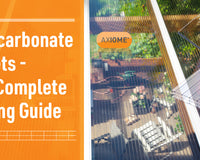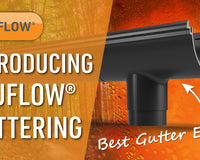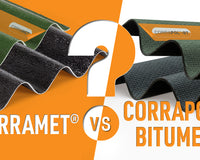The best width for Twinwall Polycarbonate Sheets when using for roof glazing is between 600 and 1050mm, however, this depends on a few other factors such as the thickness of the sheet, location of the project (e.g. is it in an exposed or sheltered area), and the pitch of the roof.
In this article, we explain the 5 key considerations that you will need to consider when deciding what width to choose for twinwall polycarbonate.
5 Key Considerations When Choosing Width for Twinwall Polycarbonate Sheets
- Choose The Best Thickness of Sheets for Spanning
- Check The Type of Rafter Supports
- Be Aware Expansion & Contraction of Twinwall Polycarbonate
- Consider Ease of Installation
- Ensuring The Best Possible Safety
Choose The Best Thickness of Sheets for Spanning
Generally, the thicker the twinwall sheets the wider you can span. However, there should be a general limit of 1050mm in most applications.
So, here’s what you should consider when choosing what thickness of twinwall polycarbonate you will use.
Thinner sheets such as 6mm and 10mm twinwall polycarbonate are a lower cost, however, they will require rafter support at much narrower centres, such as 450-600mm depending on the other factors. Furthermore, unless they are properly secured they are more likely to fail with snow loading or be ripped off in high winds.
This means that you could be paying more for the overall project by having to pay for more rafters, whereas sometimes choosing a thicker sheet. For example, choosing 16mm triplewall polycarbonate or 25mm polycarbonate sheet may mean the sheet is strong enough to span 700mm – 1050mm centres, which in turn means that there are fewer rafters which saves overall cost.
Additionally, you end up with a much stronger roof sheet which will last longer. It also increases the overall area of daylight.
Here’s a simple chart to illustrate typical widths for Axiome® multiwall polycarbonate sheets
|
Axiome Polycarbonate Sheet Thickness |
Recommended* Sheet Width |
|
Not recommended for Roof Glazing |
|
|
400mm |
|
|
600 - 700mm |
|
|
750 - 1000mm |
|
|
800 - 1050mm |
|
|
800 - 1050mm |
|
|
*Inasmuch as Clear Amber Shop has no control over the circumstances in which materials may be used, we cannot guarantee that any particular results will be achieved. Users should carry out their own tests and obtain structural engineer calculations as required to determine the suitability of the material for their application. Installers should satisfy themselves that their designs are sufficient to provide adequate strength for the intended use and to meet regional loading requirements. |
|
Another option you could consider if you want to use a thinner sheet with wider rafter centres is adding noggins (Sometimes called dwangs) which are additional side-to-side supports between the rafters, which support the sheet laterally between the rafters. However, bear in mind that this will tend to look less aesthetically pleasing, and will reduce the overall daylight effect.
Check The Type of Rafter Supports
You should also consider the structure of the rafters. For most areas, you will need a rafter at least every metre. For roofs with longer slopes/projections, you will need more rafters to cope with the required spanning strength, therefore with narrower rafters, it makes much more sense to use narrow sheet widths to suit.
If you are using timber rafters, they can be lower cost, and timber rafters give a more traditional look, however, they may require some maintenance or painting. To protect timber rafters always use good quality aluminium glazing bars which are designed for fixing glass or polycarbonate on to rafters.

Another great option is to choose aluminium self-supported rafters which are always exactly straight and don’t require any finishing or much maintenance. Using aluminium self-supported glazing bars also means that you can be more certain of their spanning capabilities.
Aluminium self-supporting glazing bars will normally come in two depths to provide different levels of strength depending on the spanning distance. For example, a low-profile aluminium glazing bar may span up to 3m, whereas a high-span glazing bar could span up to 5m or 6m.
It is always wise to err on the side of caution and use narrower centres between rafters to provide optimum strength, however, in any case, you should always seek professional advice from a structural engineer to provide the correct calculations for you for each specific job.
Be Aware Expansion & Contraction of Twinwall Polycarbonate
It’s always best practice to glaze individual sheets between each rafter with a quality glazing bar holding the twinwall polycarbonate sheets in place. This is because the sheets need space in between for thermal expansion and contraction.
Whilst polycarbonate sheets are manufactured up to 2100mm wide, it’s not wise to glaze them any wider than 1050mm approximately, because you need to allow for them to expand and contract at each rafter join. This reduces the possibility of the sheets warping. That said in some situations where there is less sunlight for example you could glaze wider sheets, but there are a couple of other reasons below that also reiterate that narrower sheets of say 1050mm or less are generally the best size to use.
Consider Ease of Installation
Another reason why you are best to choose 1050mm or less for sheet widths is due to ease of installation.
Larger-width sheets can be very unwieldy to handle and get easily caught in the wind during installation, which makes installation challenging and could cause damage to the sheets or property. Given there is no advantage in using wider sheets, then we recommend using narrower sheets to make the installation process as easy and fast as possible.
Ensuring The Best Possible Safety
Last but not least, it’s important to consider safety.
When installing twinwall polycarbonate sheets you generally have to lean across the sheets whilst working at height to secure both sides of the sheet with glazing bars or flashings. You should always take care to ensure you do this safely with the correct access equipment to make sure you are not in danger of falling or any other injury.
Furthermore, it’s a lot easier and safer to lean across a narrow width of polycarbonate sheet to fix it with the glazing bars. Snap-down glazing bars require a plastic-headed hammer to snap-fix them down, and screw-down glazing bars require screws to be fixed down, but in any event the narrower the sheet the easier it is to install.
Generally speaking, choosing thicker sheets at narrower widths together with strong rafters at narrow centres will give peace of mind regarding the strength, longevity, and safety of the roof.
What is The best Width for Solid Polycarbonate Sheets?
There are different types of polycarbonate sheets such as solid sheets and twin wall polycarbonate sheets. In this article we have been referring to multiwall sheeting, which is generally more cost effective. However, solid polycarbonate provides a clearer view as it doesn’t have the flute lines that twin wall polycarbonate has. In addition, solid polycarbonate is much stronger for impact resistance than multiwall polycarbonate.
For solid polycarbonate sheeting you would need to reduce the rafter centres down to 400mm – 600mm depending on the thickness. To increase this width, you can consider either adding in noggins in between the rafters, or alternatively extra strength can be achieved if the rafters are curved.
Once again, it is important that you always consult with a professional and structural engineer to make sure you get the correct loadings for your specific project design.
Related Articles:
- Polycarbonate Sheets – Complete Buying Guide
- Best 3 Glazing Bars For Glass & Polycarbonate
- Joining Polycarbonate Sheets Guide
Need Help with your Polycarbonate Sheet Project?
If you are needing help building a quote for our polycarbonate sheets please get in touch. Our Team will be happy to assist on our Live Chat or you can email shop@clearamber.com where our we will provide you with all the advice and support you require for your project.
Place Your Order Today – Get Same Day Despatch, Free Returns & Flexible Payment!















4 comments
Anonymous
Thanks Ashley, it depends on the thickness of multiwall polycarbonate sheet that you are using but for 25mm or 35mm we would suggest 800-1050mm centres. Some people go wider but depends very much on local wind and the structure etc.
Ashley
I’m building a pergola and was going to use multi wall poly what is the recommend centres for joists these are going to be 2 × 6
3m in length
Regards
Ashley
Anonymous
Thanks for the question Allan. We don’t tend to send the offcuts for polycarbonate sheets as most people just want the specific cut sizes. However, if you request the offcuts when placing we can certainly include these for you.
Allan Parkin
I have placed a few sheets in my basket and requested that it is cut to size is it standard practice to also send the part that has been cut off?